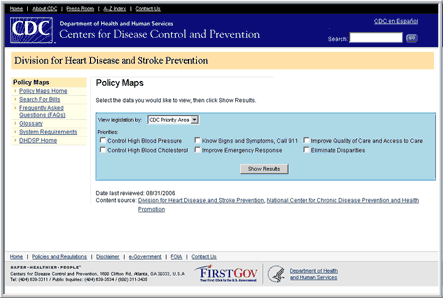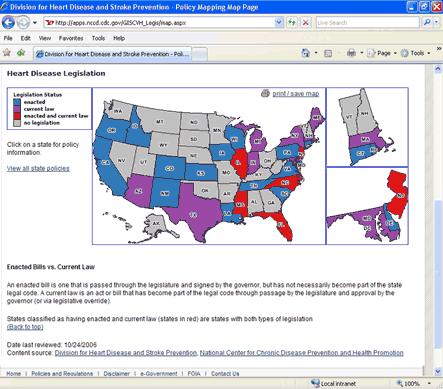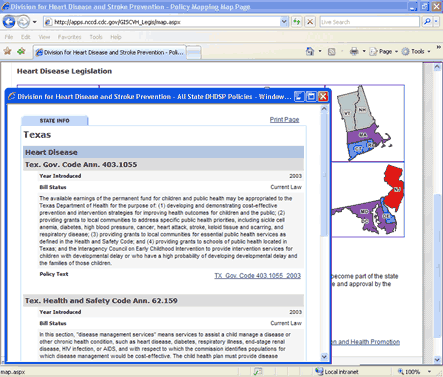

|

|

Volume 5: No.
2, April 2008
TOOLS AND TECHNIQUES
Tools for Developing, Implementing, and Evaluating State Policy
Bernadette Ford Lattimore, MPH, So O’Neil, MS, Melanie Besculides, DrPH
Suggested citation for this article: Ford Lattimore B, O’Neil S, Besculides M. Tools for developing, implementing, and evaluating state policy. Prev Chronic Dis 2008;5(2).
http://www.cdc.gov/pcd/issues/2008/
apr/07_0210.htm. Accessed [date].
Abstract
Policy can improve health by initiating changes in physical, economic, and social environments. In contrast to interventions focused on individual people, policies have the potential to affect health across populations. For this reason, the Division for Heart Disease and Stroke Prevention of the Centers for Disease Control and Prevention (CDC) advises states funded under the Heart Disease and Stroke Prevention Program to
engage in activities supporting the development and maintenance of policies that
can help reduce the burden
of cardiovascular disease.
Currently, the Division for Heart Disease and Stroke Prevention funds programs in 33 states and the District of Columbia to promote cardiovascular health. One goal of these programs is to build states’ capacity to develop, implement, track, and sustain population-based interventions that address heart disease and stroke. Because of the critical role of policy in these activities, CDC provides guidance in developing, implementing, and evaluating policy. In 2004, the division
contracted with Mathematica Policy Research, Inc, to conduct the Heart Disease and Stroke Prevention Policy Project, which included development of an online database of state heart disease and stroke prevention policies and a mapping application to
show which states have these policies.
We discuss the method for developing the database, mapping application, and other tools to assist states in developing, implementing, and evaluating heart disease and stroke prevention policies. We also highlight lessons learned in developing these tools and ways that states can use the tools in their policy and program planning.
Back to top
Introduction
Policies, which consist of laws, regulations, and rules, can determine how organizations providing health services are funded, organized, or held accountable and can change physical, economic, and social environments
(1). As a result, a policy is a type of intervention that can significantly affect health over the long term. Legislation establishing smoke-free policies is a good example. Secondhand smoke, a known carcinogen, causes 35,000 deaths from heart disease and 3,000 deaths from lung
cancer annually among nonsmokers in the United States (2). Knowledge of these
statistics led to smoke-free policies in a number of states, with smoking banned within entire venues. Exposure to secondhand smoke soon decreased sharply, in part because of social and environmental changes brought about by these policies.
To provide leadership in improving cardiovascular health nationwide, reducing
cardiovascular disease, and eliminating disparities in heart
disease and stroke, Congress mandated in 1998 the creation of the Cardiovascular
Health Branch of the Centers for Disease Control and Prevention (CDC).
To help support its mission,
the branch initiated a national, state-based heart disease and stroke
prevention (HDSP) program with funding for eight states. The branch became the
Division for Heart Disease and Stroke Prevention in January 2006. Currently,
state HDSP programs exist in 33 states and the District of Columbia.
These state programs address six priority areas
established by the division: controlling high blood pressure, controlling high blood cholesterol, increasing awareness of the signs and symptoms of heart attack and stroke, improving emergency response, improving quality of care, and eliminating health
disparities. To measure progress in these areas, the programs monitor cardiovascular disease and its related risk factors and assess policy and environmental
support for the prevention of heart disease and stroke in their individual
states. A new
funding cycle that began June 30, 2007, supports the same number of states (but
not all of the same states) and the District of Columbia.
As outlined in its funding requirements, the Division for Heart Disease and Stroke Prevention emphasizes the need for policies aimed at preventing heart disease and stroke. Feedback from state programs, however, revealed a need for more research documenting the effectiveness of different prevention policies to help determine how best to channel their limited resources. This type of research can be difficult for states to conduct on a large scale themselves because
they often lack the resources or
technical expertise to evaluate policy interventions.
To answer this need, the division contracted with Mathematica Policy Research, Inc (MPR), in 2004 to conduct the HDSP Policy Project for the purpose of developing an annotated bibliography of state HDSP policy sources; a centralized, online database of policies from all 50 states and the District of Columbia;
a mapping application indicating where HDSP policies exist; a guide outlining the fundamentals of HDSP
policy making; and a handbook on using an adapted RE-AIM (www.re-aim.org *) framework to assess these policies
(3). RE-AIM, which stands for the five components of an evaluation framework (reach, efficacy, adoption, implementation, and maintenance), is commonly used
to systematically evaluate interventions for changing health behaviors. These products
can help states understand the policy process and easily access state HDSP
policy information. With the database, a state can decide which policies are
applicable and replicable in its specific jurisdictions and track policies over
time. State HDSP programs can also find guidance on developing, implementing, and evaluating policies to prevent
cardiovascular disease.
In developing the HDSP Policy Project, CDC and MPR conducted a comprehensive literature review, a focus group with representatives of state HDSP programs, and interviews with policy experts. To guide the process, we convened an advisory panel of experts in the field of heart disease and stroke and in policy and environmental interventions. Members were from government, health care, and advocacy organizations. This article describes the creation of the online tools and related products and
highlights the challenges and lessons learned in conducting a project of this magnitude.
Back to top
The Online HDSP Policy Database and Mapping
Application
Literature review and annotated bibliography
The project began with an extensive literature review that took place from September 2004
through June 2005 and resulted in an annotated bibliography database, created in ProCite (Thomson Corporation, Stamford, Connecticut), that contained 174 sources of HDSP state policies and activities. The sources included reports, Web sites, newsletters, guidelines, and press releases related to the prevention of heart disease and stroke. We excluded policies dealing specifically with cardiovascular
disease risk factors because policy databases already exist for these. A link on the HDSP Policy Project Web site takes users to a bibliography of the original sources of the policies in the database.
Web site
From sources gathered in the annotated bibliography database, we identified 207 policies to populate the HDSP
policy database. The policies we
found were in force either from 1978 through 2005 or at some time during that period. To house the policies systematically, we created an Excel (Microsoft Corporation, Redmond, Washington) spreadsheet based on the following information:
- State
- Bill number
- Status (whether a bill is enacted or is current law [An enacted bill has been passed through the legislature and signed by the governor but has not necessarily become part of the state legal code; a current law has become part of the legal code.])
- Year (when the bill was passed)
- Topic area
- CDC priority area
- Policy abstract
- PDF file name of policy
After completing the database, we created a Web site using as a template the code from the legislative database
Web site of CDC’s Division of Nutrition, Physical Activity, and Obesity. Microsoft SQL Server (Microsoft Corporation, Redmond, Washington) was used to design and maintain the Web site.
The HDSP policy database and user's guide, a list of frequently asked questions, CDC contact information, a site map, and links to additional resources are included to assist users. An administrative Web site,
available only to authorized personnel, allows for updating or modifying the database when new resources become available.
Mapping application
The mapping application allows users to see the distribution of enacted or current HDSP policies across the United States (Figure 1). To begin the process, CDC teamed with experts in geographic information systems from Northrop Grumman Corporation, including a usability engineer who pilot tested the application. Users can view legislation by CDC priority area or by topic. For example, if the user selects heart disease as the search topic, a color-coded map of the United States appears
(Figure 2) showing which states have enacted laws, current laws, both enacted and current laws, or no legislation related to heart disease. The user can then click on a state and view information about the legislation, including the year it was introduced, its status, a summary of the policy, and a link to the legislation in its entirety (Figure 3).

[ View enlarged image and descriptive text ]
Figure 1. Home page of the mapping application for the Heart Disease and Stroke Prevention Policy Project, Centers for Disease Control and Prevention, United States.

[ View enlarged image and descriptive text ]
Figure 2. Web page indicating states with heart disease legislation for 1978–2005, Heart Disease and Stroke Prevention Policy Project,
Centers for Disease Control and Prevention, United States.

[ View enlarged image and descriptive text ]
Figure 3. Web page detailing heart disease legislation for Texas, Heart Disease and Stroke Prevention Policy Project, Centers for Disease Control and Prevention, United States.
Back to top
Other Policy Tools
Guide to policy making
CDC and MPR used information from the focus groups and interviews with policy experts to create the Guide to the ABCs of State Heart Disease and Stroke Policymaking
(4). Highlights of the guide include an outline of the policy-making process, the role of state and local health departments in developing policy, challenges to implementing policy, and the reasons that policy evaluation is not commonly written into legislation. The following key findings emerged:
- Mandates to enact and enforce regulations should be adequately funded.
- Policy should be developed at the community level to gain local support that can then spread to the rest of the state.
- Partnerships with stakeholders should be created to help advocate for HDSP policies.
- Limitations in data can hinder policy evaluation.
The guide can be used in numerous ways. For example, a new HDSP program manager who is unfamiliar with how policies are developed in the state can go to the guide for the tools needed to effectively participate in policy development. For a task force on stroke, the guide offers information
about the challenges of implementing policy in that area.
Handbook on policy assessment
Because illustrating outcomes of policies can be helpful to state programs and other stakeholders, CDC and MPR created Assessing Heart Disease and Stroke Prevention Policies
With the RE-AIM Framework.
The handbook outlines the assessment of selected policies from each of the six
CDC priority areas using an adapted version of the RE-AIM framework (3). We used RE-AIM because its system-based and social-ecologic components allow for the assessment
of interventions at multiple levels. Linking long-term outcomes to a policy proved difficult, however, because most HDSP policies are too recent to have measurably influenced long-term outcomes such as
changes in health status. We, therefore, adapted the RE-AIM framework to capture short-term outcomes, such as policy implementation, and intermediate-term outcomes, such as increased program surveillance (Table).
To collect the data needed to assess the seven selected policies, we reviewed, recorded, and filed information needed to use the RE-AIM framework; developed interview guides for each of the seven policies; and interviewed, primarily by telephone, the experts whom we had identified. We organized interview notes within the parameters of the RE-AIM framework to facilitate analysis. The resulting handbook contains an analysis and summary table for each policy and the methods used to apply RE-AIM
to the assessments and discusses challenges in using RE-AIM to assess policies. The following key findings emerged:
- Reporting and collecting data are essential to improving ongoing activities and assessing the
outcomes of a policy.
- Legislative support is necessary to ensure the passage of policy, funding for implementing and maintaining policies, and the success of activities resulting from a policy.
- A strong evidence base increases the chances that a policy will be adopted and implemented.
- Involvement of different stakeholders, including consumers, providers, and legislators, in policy making ensures that policies are smoothly adopted, implemented, and maintained.
The handbook provides a method of assessing policies in the event that resources are unavailable to evaluate a mandated policy. For example, suppose a policy to create a stroke task force was passed 5 years ago without any funding for evaluation. The state HDSP program could consult the handbook to find out how to
adapt the RE-AIM framework to assess the policy and could then use the assessment to determine what changes would
potentially increase the effectiveness of the task force.
Back to top
Lessons Learned
The following lessons were learned from the HDSP Policy Project:
- An advisory panel can provide valuable insight, ideas, and resources for a project. Contributions of this project’s advisory panel included reviewing drafts of the documents and providing
key considerations for assessing policies.
- Having a mapping application in addition to an online database is helpful for users who are visual learners or who find printed maps valuable when communicating with stakeholders.
- The RE-AIM framework may be adapted to assess policies.
Although the process is challenging, focusing measurement on the outcomes stated in legislation
provides clear parameters for the adaptation. Validation of the adaptation is an
area for future research.
- Creating logic models to provide an organized visual representation of short-term, intermediate, and long-term outcomes is crucial and allows for systematic assessment.
- Policy evaluation is time-sensitive. The less time between a policy’s implementation and its evaluation, the less information is available about the
effect of the policy.
Back to top
Conclusion
The 2-year HDSP Policy Project provided stakeholders with important tools for supporting HDSP policy activities in their states. These products are available at www.cdc.gov/dhdsp/dhdspleg and from CDC’s Division for Heart Disease and Stroke Prevention Web site (www.cdc.gov/dhdsp). CDC plans to update
the database annually. With these tools, funded state programs and other stakeholders can gain insight into policy, its application, and its impact on heart disease and stroke.
Back to top
Acknowledgments
The HDSP Policy Project was supported by CDC’s Division for Heart Disease and Stroke Prevention under contract 200-2001-00122 with Mathematica Policy Research, Inc. Thanks to Sarah Blake
of Emory University for assisting with the focus groups and interviews with policy experts. We thank the project’s advisory panel for their advice and guidance: Tim LaPier, Ahmed Liban, and Ron Todd
of CDC; Allan Khoury of Whole Health Management, Inc; Libby Puckett and Molly Brennan, formerly
with the North
Carolina HDSP Program; Alexander White of the North Carolina HDSP Program; Mark Schoeberl
of the American Stroke Association (a division of the American Heart Association); Stephanie Bailey, formerly with the Metro Public Health Department of Nashville/Davidson County; and Julie Harvill, formerly with the Illinois HDSP Program. We thank Michele Casper at CDC and David Ray, Jeanie Barker, Amy Edmonds, and others at Northrop Grumman Corporation for their assistance and expertise on the mapping
application and Susan Davis (CDC) for getting the products online. Finally, we thank the policy experts for their assistance in developing the guide to the fundamentals of policy making and the policy assessment handbook.
Back to top
Author Information
Corresponding Author: Bernadette Ford Lattimore, Division for Heart Disease and Stroke Prevention, National Center for Chronic Disease Prevention and Health Promotion, Centers for Disease Control and Prevention, 4770 Buford Hwy NE, MS K-47, Atlanta, GA 30341. Telephone: 770-488-5208. E-mail: blford@cdc.gov.
Author Affiliations: So O’Neil, Melanie Besculides, Mathematica Policy Research, Inc,
Princeton, New Jersey.
Back to top
References
- Association of State and Territorial Directors of Health Promotion and Public Health Education, Centers for Disease Control and Prevention. Policy and environmental change: new directions for public health. Santa Cruz (CA): ToucanEd; 2001.
- Centers for Disease Control and Prevention.
State smoking restrictions for private-sector worksites, restaurants, and bars — United States, 1998 and 2004. MMWR Morb Mortal Wkly Rep 2005;54(26):649-53.
- Glasgow RE, Vogt TM, Boles SM.
Evaluating the public health impact of health promotion interventions: the RE-AIM framework. Am J Public Health 1999;89(9):1322-7.
- Guide to the ABCs of state heart disease and stroke
policymaking. Atlanta (GA): Centers for Disease Control and Prevention;2006. http://apps.nccd.cdc.gov/DHDSPLeg/docs/6109-320.pdf.
Back to top
|
|
